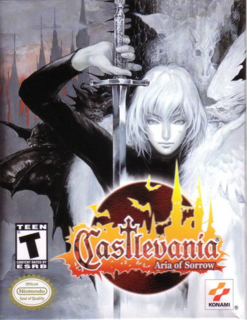Best of the GBA Castlevania games, and the best of the exploration Castlevania games as well
Game-play/Play-mechanics: Aria of Sorrow implements an all new primary concept to the game-play, that being the ability of Soma to sometimes gain possession of the soul of an enemy creature that he has defeated. This in turn can be equipped for various special-attacks, enhanced status resistance, or stat-boosts; there are three categories of soul-powers to utilize, and one from each can be equipped simultaneously. Every monster/enemy in the game has a catch-able soul, some are more difficult to acquire than others, and it may even take a few times through the game to get all of them as some enemies are very stubborn about relinquishing them. The rest of the game-content pretty much plays out like standard adventure/exploration Castlevania; as with the last two GBA adventures there is a big castle to explore which is represented by a map that auto-maps as you explore the premises. The castle-design is the most impressive for a “Metroid-vania” type game, and even though the game is not as long as the other similar Castlevania games, (About eight hours the first time through) the castle layout is much more intricate and engaging than the other games in the series. Every area that the castle is made up of is well-implemented and has a interesting theme; furthermore the seemingly endless hallways are almost non-existent, something that was a big issue with Harmony of Dissonance, and therefore the game-play in Aria of Sorrow features a much stronger value.
Like the other Castlevania adventure-focused games there is a wide assortment of swords, axes, and lances/spears to make use of, and of course a plethora of armor to provide protection and enhance status; also are the special abilities that will allow Soma to access new areas and also enhance the play-control. The enemies are a large and varied bunch, and it is fun to figure out the best way to deal with each of them, and the bosses are moderately challenging and memorable encounters. I also like the NPC’s and the story of the game, which is modest but still cool. Julius Belmont is the best Belmont character since Simon from the early games. I almost never play a game more than once anymore, haven’t since the 16-bit era really, yet I played through Aria of Sorrow at least seven times, the more modest length of the game actually works in its’ favor for replay value, and the game-play overall is very high on the fun-factor. Aria of Sorrow strikes the perfect balance between platforming, enemy encounters, and exploration; it is the first adventure/exploration Castlevania to really achieve that, and that is because the castle is more concentrated and focused on quality without the filler areas that are found in the other exploration Castlevania games.
Visuals/Artwork: Some of the best artwork and graphics to be found on the GBA portable are presented in Aria of Sorrow, each area looks great and all are distinctive from one another. Some areas feature some nice parallax scrolling and others have some more active and flashy backgrounds. The enemies have also received a lot of little visual details and obviously much individual attention went into their illustrations and animation. Bosses are also a quality group with moderately sized boss creatures as well as screen-filling bosses being present. The color-scheme could perhaps be a little more vibrant but that is nitpicking somewhat, especially because this is a GBA game.
Music/Sound: A very impressive soundtrack, one of the best for a Castlevania game, even with the limitations of the GBA sound-chip. You get grand-scale classical themes, soft, haunting, and melodic pieces, and the more standard upbeat and catchy themes. The arrangements by-in-large are some of the more cleverly written of the Castlevania franchise, and all of the music is completely original and exclusive to Aria of Sorrow. Aria of Sorrow is an outstanding game-play package, with plenty of hidden extras, and it is the second-best Castlevania developed-only to Castlevania 4-in my opinion.

